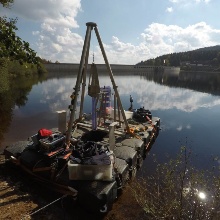• Floor area ground floor: 1600 m² (88m x18m), clear height 11m
• Floor area basement: 670 m²
• Outdoor area: 300 m²
• Underground water tanks with a volume of 1250m³ (divided into two compartments)
• Two high level tanks (maximum pressure height 12.5m)
• Installed pump capacity of 800l/s
• Mobile pumps (capacity up to 100l/s)
• Soil and sediment laboratory
• Metal, plastic and wood workshops
• Electronics and measuring equipment laboratory
• Several vehicles for carrying out field measurement campaigns
• Tilting flume 27.0m x 1.0m x 0.6m (adjustable inclination -1% to 5%; capacity 300l/s)
• Tilting flume 8.0m x 0.25m x 0.3m (adjustable inclination 0% to 3%; capacity 40l/s)
• Tilting flume 8.0m x 1.50m x 1.0m (adjustable inclination 1:3.2 to 1:20; capacity 500l/s)
• Experimental equipment for radiometric density measurement (based on absorption)
• Experimental facility for the determination of the depth-dependent erosion stability of sediments (SETEG)
• Mobile device for obtaining sediment cores (Frahm-Lot + pontoon)
• Various ADV measuring devices (Acoustic Doppler Velocimetry)
• ADCP (Acoustic Doppler Current Profiler) with echo sounder and catamaran
• Stereo PIV system for measurements of multidimensional flow fields (Particle Image Velocimetry)
• LDA (Laser Doppler Anemometer), two-component system with computer-aided traversing device
• Magnetic-inductive flow meters
• Differential GPS system in combination with tachymetry
• Optical and acoustic sensors for sediment surface measurement (with computer-aided traversing device)
• Acoustic sensors for water level measurement (ultrasound)
• Turbidity meters for suspended sediment concentration measurements in the laboratory and for field applications (scattered light method)
• Sensors for recording various parameters in water bodies (temperature, pH value, conductivity, oxygen content, ...)
• Sieving machines (dry sieve tower)
• Freezecore-/Freezeplate-System for the sampling of undisturbed sediment samples in gravelly watercourses
• Mobile in-situ system for measuring critical bottom shear stresses of cohesive sediments
• Measuring system for the determination of particle size distributions (laser diffractometer)
• Dam model for demonstrating dam failure
• Weir model (over- and underflow, hydraulic jump)
• Pipeline model (for determining losses)
• Test stand for water hammer investigations



